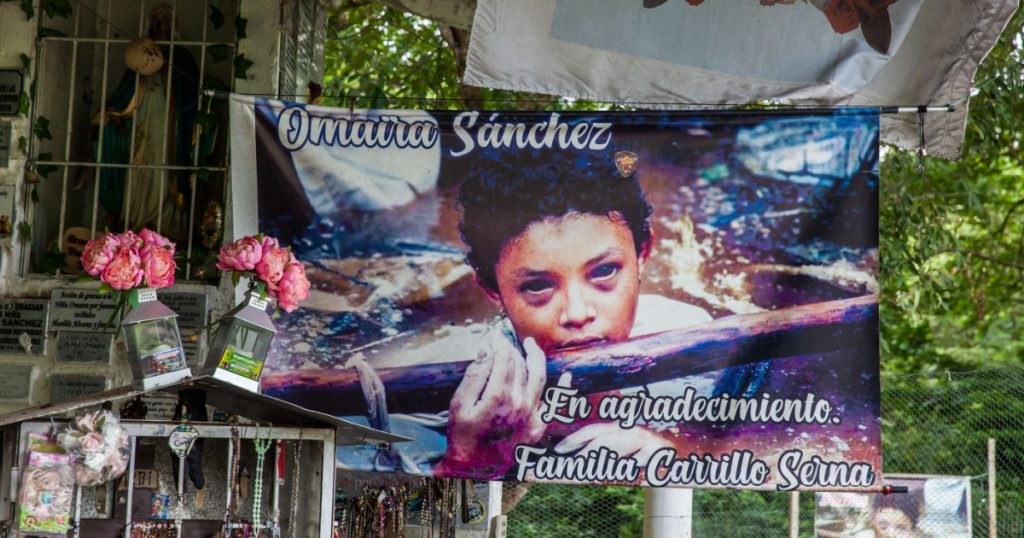In November 1985, a natural disaster struck the small town of Armero, Colombia. The eruption of the Nevado del Ruiz volcano triggered a massive mudflow, claiming the lives of over 25,000 people. Among the victims, the tragic story of Omayra Sánchez stands out as a symbol of the horror the catastrophe brought. This is the harrowing 60-hour ordeal of 13-year-old Omayra Sánchez, who became trapped in the volcanic mudflow and captured the world’s heart.

The Eruption and Its Aftermath

The Nevado del Ruiz volcano, towering 17,500 feet above sea level, had been showing signs of activity since the 1840s. By September 1985, the tremors became alarming, but authorities assured residents that there was no cause for concern. Then, on November 13, 1985, the volcano erupted, melting the ice cap covering the Arenas Crater and unleashing a devastating lahar. The mudflow, running at approximately 25 mph, engulfed Armero in minutes, covering 85% of the city in thick sludge.
Omayra Sánchez’s Ordeal

Omayra Sánchez was at home when the lahar destroyed her house. Trapped beneath the rubble, she found herself neck-deep in mud and debris. Rescue workers and journalists quickly surrounded her, but despite their efforts, they could not free her. Her legs were pinned by the remains of her house, and rescuers lacked the equipment to save her without causing fatal injuries.
For three excruciating days, Omayra remained trapped. Volunteers and Red Cross workers did everything possible to make her comfortable. Divers tried to free her but found that any attempt to move the debris risked causing further injury or death. The continuous rain exacerbated the situation, raising the water level around her and making the rescue even more challenging.
The Last Moments

Photographer Frank Fournier arrived in Armero and documented Omayra’s final hours. His haunting photographs of the young girl, floating in and out of consciousness, captured her immense suffering. Omayra spoke to the volunteers and journalists with remarkable composure, worrying about missing school and her family.3 As her condition deteriorated, she began hallucinating, thinking she had to get to a math test.
Omayra’s final words were a heart-wrenching messages of love to her family: “Mommy, I love you so much, Daddy, I love you, brother, I love you.” On November 16, 1985, after more than 60 hours trapped in the mudflow, Omayra died, likely from gangrene or hypothermia. Her death, captured on camera, sparked global outrage and criticism of the Colombian government’s inadequate response to the disaster.
Global Reaction and Aftermath

The world was stunned by Omayra Sánchez’s story. Fournier’s photographs, particularly the one above, showing her black-eyed and drenched in mud, won the 1986 World Press Photo of the Year. The image not only brought international attention to the tragedy but also highlighted the failures of the rescue operation. Witnesses and volunteers described the chaotic and under-resourced response as having “minimal involvement from the Colombian army and police.”
The Colombian government faced severe criticism for its lack of preparation and response to the volcanic threat. General Miguel Vega Uribe, the minister of defense, argued that the government did all it could, citing the country’s underdeveloped status and limited resources. However, the public and international community remained unconvinced, calling for better disaster preparedness and more effective rescue efforts.
Legacy and Memorials

Today, Armero remains a haunting reminder of the tragedy. The site is largely abandoned, with only ruins and a few memorials marking where the town once stood. Each year, on November 13, a ceremony commemorates the victims, with helicopters dropping flowers over the site. Omayra Sánchez’s grave has become a pilgrimage site, where people leave trinkets and notes, treating her as almost saint-like. Survivors of the Armero tragedy, like Alma Landinez and Olga Villalobos, continue to share their stories, ensuring that the memory of the disaster and its victims endures.
Conclusion

Omayra Sánchez’s story is a stark reminder of the devastating power of natural disasters and the importance of effective disaster preparedness. Her courage and dignity in the face of unimaginable suffering touched hearts around the world, making her a lasting symbol of the Armero tragedy. As we remember Omayra and the thousands of others who perished, we must strive to prevent such tragedies from happening again through better planning, resources, and global cooperation.

